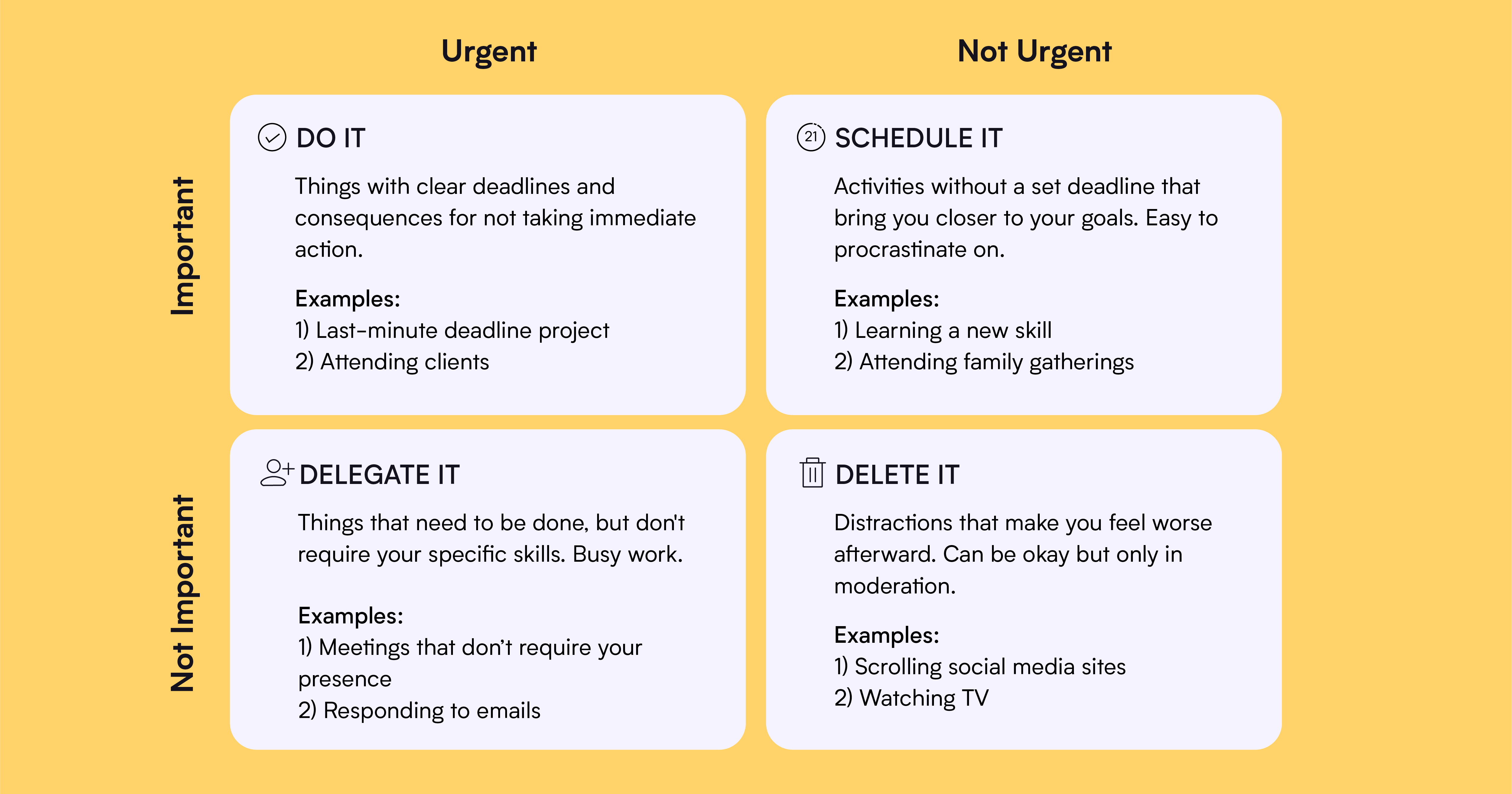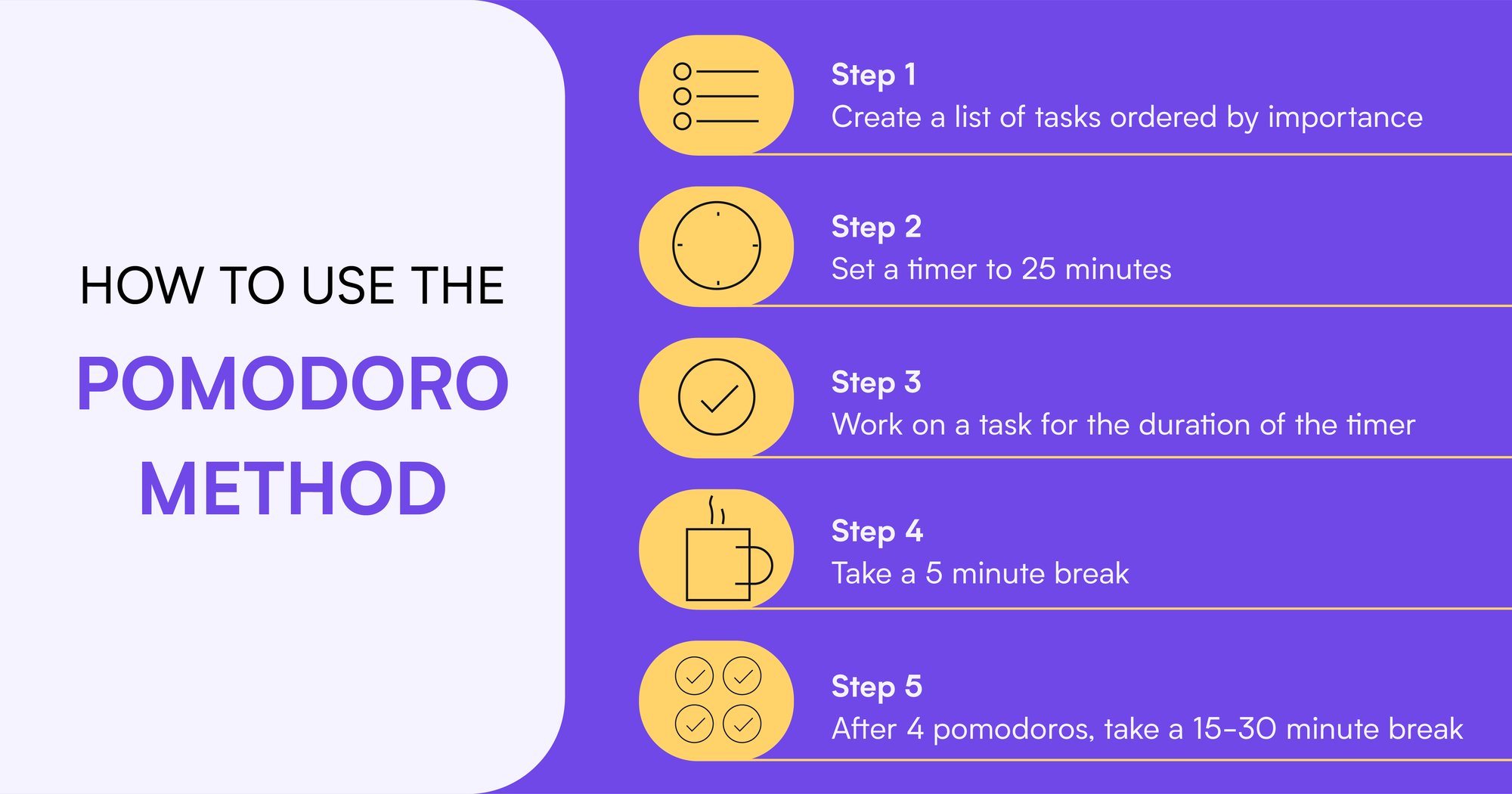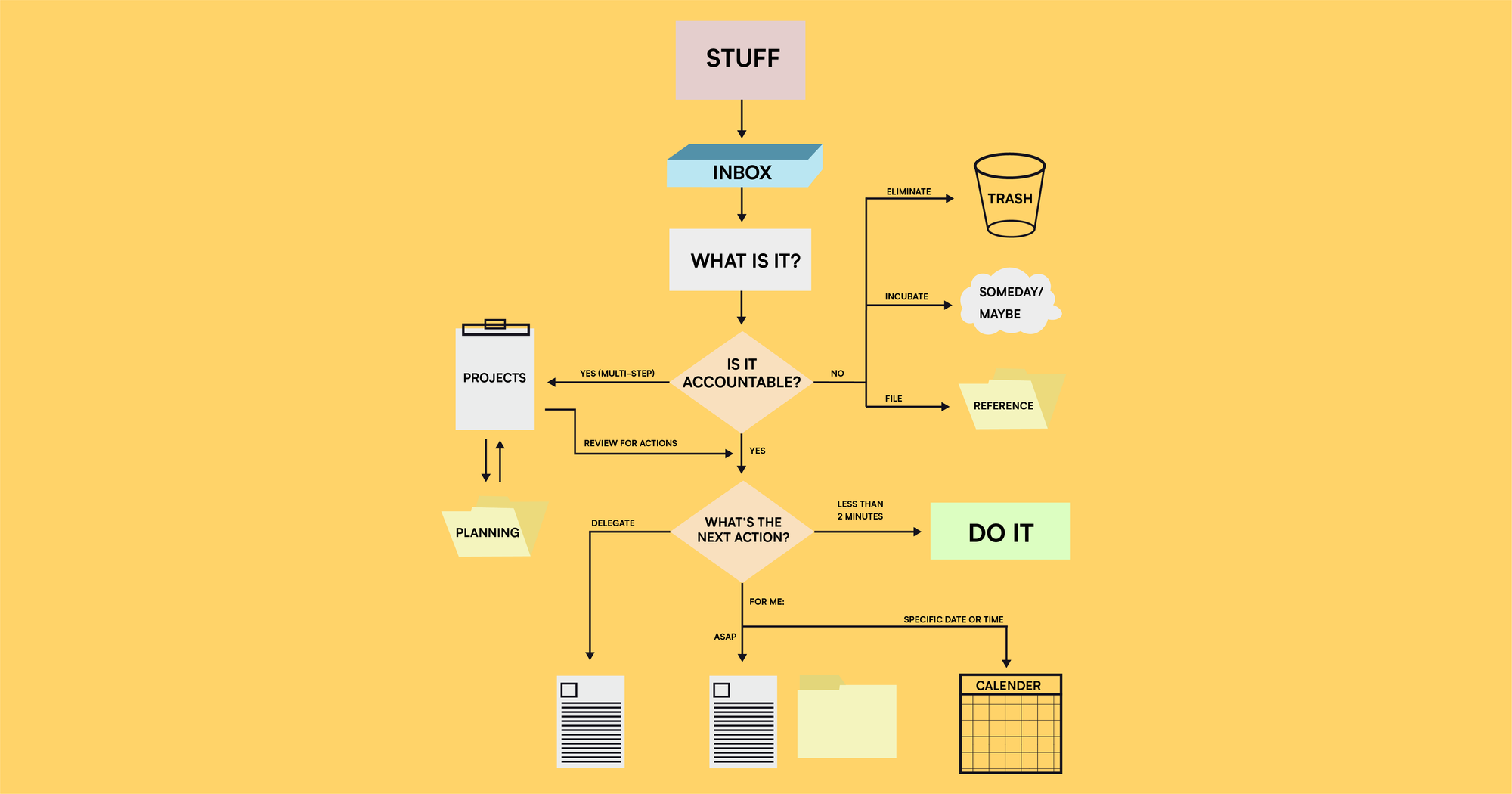Own your time: 5 time management strategies for highly effective people

Everyone wants to master their time. Whether you’re a student, an employee, an executive, or a freelancer, you know time management will help you complete your tasks on time, control your schedule, and enjoy personal time.
But, how do you do it? In this post, I’ll tell you the 5 proven time management strategies successful people use to be productive.
1. The Eisenhower decision matrix
2. The Pomodoro technique
3. Getting things done (GTS) method
4. Timeboxing
5. Learn to say no
1. The Eisenhower decision matrix
The Eisenhower matrix is a 2*2 decision-making that will help you distinguish between urgent and important tasks. So that you spend your time on tasks that will help you steer toward your long-term career and life goals.
How to use it:
a) Learn the difference between urgent and important tasks.
Urgent tasks: These tasks require immediate attention. You can’t schedule them for tomorrow or weeks later. Example: Sending an urgent email, taking meetings, and attending clients.
Important tasks: These tasks prompt your long-term goals. Important tasks require planning, and may not yield sudden results. But, if you avoid them, it will distance you from the life you want to live. Example: Exercising, spending time with family and friends, and working on things that matter.
b) Divide your tasks into 4 quadrants

Important and urgent: These are time-sensitive tasks, and you have to do them now.
Important and not urgent: These tasks fall into the 'decide' bucket. Schedule these tasks to a future date and time.
Not important, but urgent: These tasks don’t require your personal attention, but you have to get them done. Delegate these types of tasks. Learn how.
Not important, and not urgent: These tasks suck your time without contributing anything toward your goals. Delete such tasks.
2. The Pomodoro Technique
Francesco Cirillo developed the Pomodoro technique. It involves breaking your tasks into 25-minutes chunks, followed by a 5 minutes break. Each time interval is known as Pomodoro.
How to use it:

a) Choose the tasks you have to do.
b) Set a timer for 25 minutes.
c) Do the task until the time beeps.
d) Take a short break of 5-10 minutes. Take a walk or just reflect on your tasks. Avoid scrolling social media. You won’t even know when you went from Twitter scrolling to binge-watching YouTube videos.
e) Repeat the pomodoro 4 times.
f) After 4 pomodoros, take a longer break of 20-30 minutes. You can take a break, practice your hobby, or just relax.
3. Getting things done (GTD) method
Productivity consultant David Allen developed the GTD time management technique. The method is based on the fact that “there’s an inverse relationship between things on your mind and those things getting done.”
David noted that the more information you hold in your brain, the more it’s difficult to decide what needs your immediate attention. As a result, you spend more time thinking about what to do than actually doing the tasks.
This information overload (and not getting things done) leads to procrastination and stress. The GTD method solves it.
Here’s how to use it:

a) Capture: Note down all the tasks that have your attention. These tasks can be as simple as sending an email to time-consuming tasks like a 4-hour writing session. The goal is to free your mind so that you don’t spend energy remembering what tasks you have to do.
b) Clarify: Divide your tasks into the following criteria:
- If the task will take less than 2 minutes, do it right away.
- If the task is better suited to someone else, delegate it.
- If the task needs to be scheduled at a later time/date, set a calendar reminder.
- If the task will take more than 1 step, plan the step-by-step method, block your time, and do that task.
- If the task is no longer a priority, delete it.
c) Organize: After you’ve clarified each task's status, decide what task you will do when. Allot time for every task in your calendar based on priority levels.
d) Engage: Now is the time to do the tasks. Ensure that each task is completed on the allotted date and time. Block the scheduled time and don’t entertain any requests during that time.
e) Reflect: Review your progress every week. See if the GTS method is helping you to get things done on time. If yes, double on what’s working. If not, analyze what’s blocking your productivity. Cut down on those things. Tweak the strategy to suit your needs. Implement the action plan next week.
4. Timeboxing
Elon Musk works 80 hours per week across his various companies: Tesla, SpaceX, Neuralink, and The Boring Company. But, he still manages time for himself. His secret? Timeboxing.
Timeboxing is blocking time for your specific tasks, and completing them during the allotted time, no matter what. This is in sync with Parkinson’s law: Work expands to fill the time for its completion.
If you give yourself 3 hours to do a task, it will take you 3 hours. But, if you give yourself 2 hours to do the same task, it will take you 2 hours.
How to use Timeboxing method:
a) Open your Google calendar. Note the 4-5 high-priority tasks you plan to do the next day.
b) Estimate the time it’s going to take for each task. Fit those tasks into time blocks.
c) Add buffer time in between tasks to make for unexpected events/tasks.
Example:
Task 1: 9 am to 11 am
Task 2: 11.15 am to 12 pm
Buffer 1: 12 pm to 1 pm.
Task 3: 1.15 pm to 2.30 pm
Break: 2.30 pm to 3 pm
Task 4: 3.15 pm to 5 pm
Buffer 2: 5 pm to 6 pm
Tips to maximize timeboxing:
a) Plan your next day's schedule in advance. It will take you 15-20 minutes.
b) Make correct guesses when allotting time to each task. You won’t be perfect from day 1. But, after a few weeks, you’ll get an idea of how long each task takes.
c) Break your larger tasks into smaller chunks and add them to your daily time blocks. For example, say you’ve to write a blog, a task that will take you 4-5 hours.
Slot your time this way:
Research: 9 am to 10 am
Writing: 10 am to 12.30 pm
Buffer: 12.30 pm to 1.15 pm
Adding visuals: 1.15 pm to 1.45 pm
Lunch break: 1.45 pm to 2.15 pm
Editing: 2.15 pm to 2.45 pm
d) Be prepared for unexpected events to come up during your schedule. Say no to those requests. But, if it’s urgent, revise your daily schedule, but do it nonetheless.
5. Learn to say no
The biggest productivity block is agreeing to every request that comes your way. If you keep saying “yes” to everyone, you won’t finish your work and will miss your important goals. The solution? Learn to say “no.”
Here’s how to do it:
a) First, change your viewpoint. Saying no doesn’t mean you reject a person, you reject the task to fulfill your work commitments. It’s important to do so because you have limited time and energy. You can’t spend it on doing others’ work.
b) Start with assessing the request. Ask yourself, “Can I postpone my current task to agree to the request without affecting my work?” If you can’t, the answer is no.
c) Next, say “no.” Don’t postpone the answer, and don’t sugarcoat it. Be straightforward. Reason your “no.” Don’t go into the full details. A simple “no,” with 2-3 lines of explanation is enough.
d) Be polite and confident when saying “no.” Strike a healthy balance between 1) not being rude and harsh, 2) and being firm about your stance.
e) Be prepared for negative backlash. No one likes hearing “no.” Often, the other person will be frustrated and will show a negative response. Don’t judge them for this.
Choose a time management technique
You don’t have to follow all the 5 techniques. Start with one and follow it religiously. For example, if you’re an excellent planner, but find yourself agreeing to every request, start with “learning to say no.” If you struggle to do tasks on time, try the ‘Timeboxing’ technique.
Mastering your time will help you get things done on time, avoid procrastination, and enjoy a work-life balance. Get started with the above strategies.





